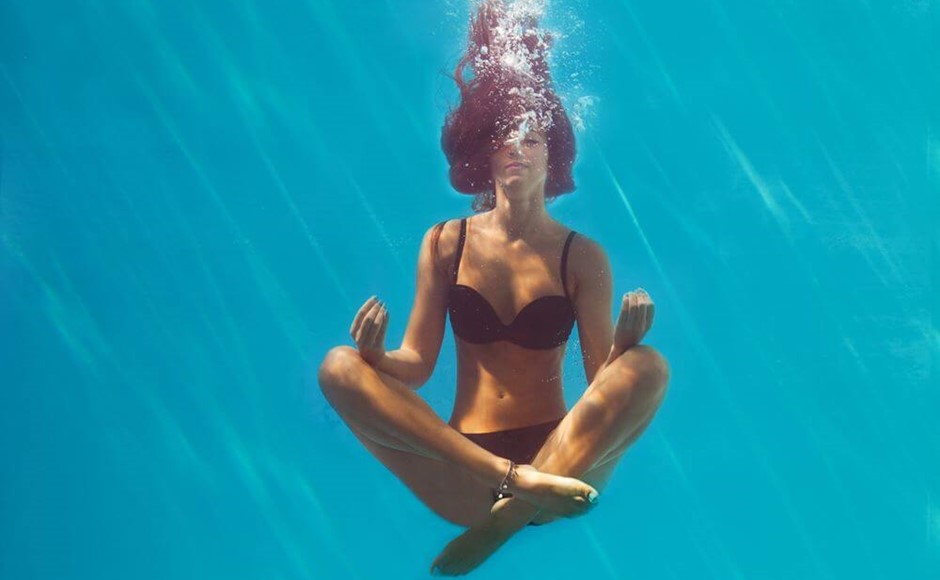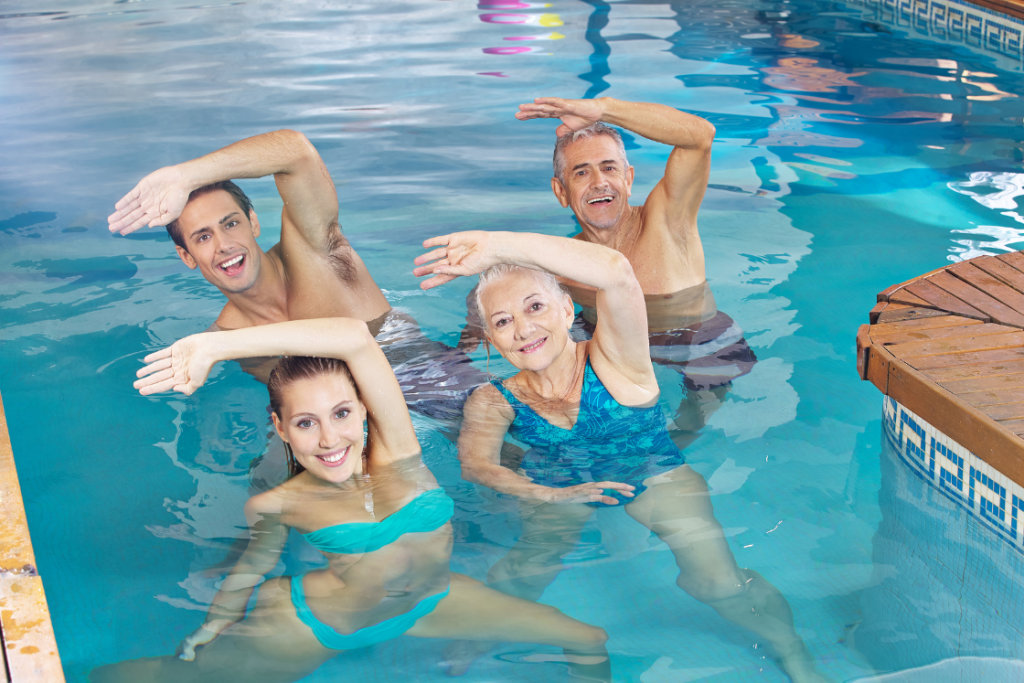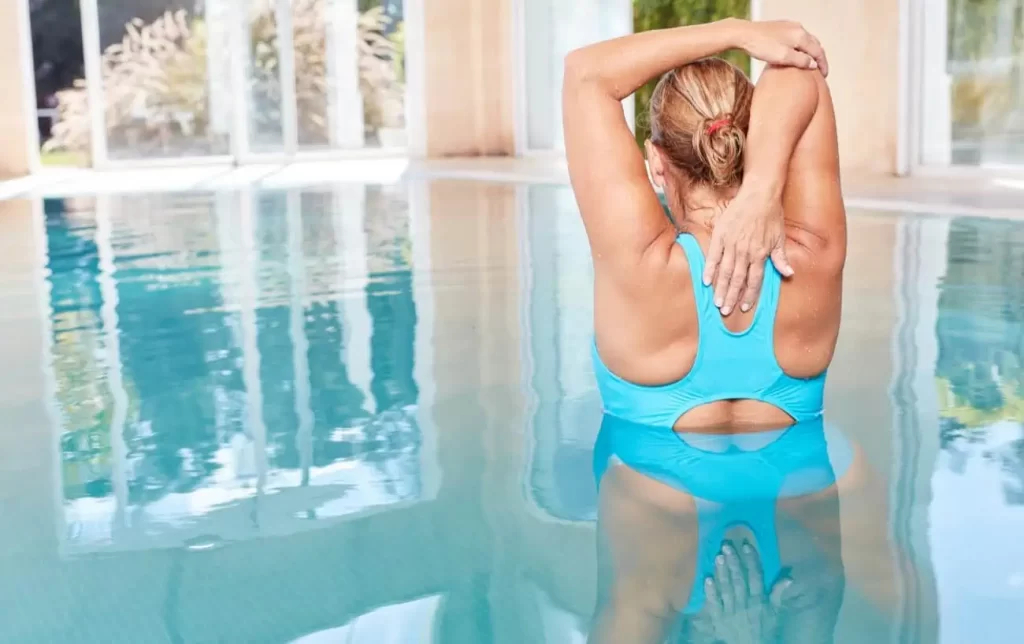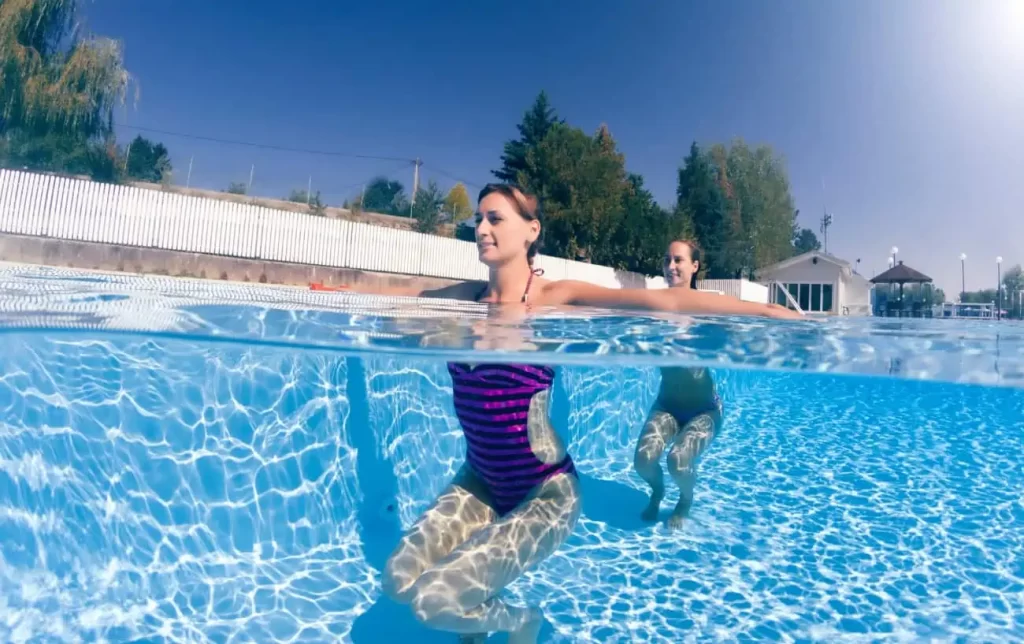
Yoga is a powerful daily practice known for improving strength, flexibility, and mental clarity. While it’s accessible to most people, certain physical conditions such as injury recovery, aging, pregnancy, or chronic pain can make traditional yoga on land challenging or uncomfortable.
Even gentle styles like Iyengar, Restorative, or Yin Yoga, which use props for support, may still put pressure on the joints or cause strain for those with limited mobility.
That’s where Aqua Yoga comes in.
Aqua Yoga is a water-based form of yoga designed to be gentle on the body while offering the same benefits as traditional yoga. Practised in a warm pool, this approach uses the natural buoyancy and resistance of water to support the body, reduce joint pressure, and promote safe movement.
This low-impact practice is gaining popularity in the U.S., especially among seniors, pregnant women, people with arthritis, and anyone seeking a more therapeutic yoga experience.
In this article, we’ll explore what Aqua Yoga is, how it works, who it’s best suited for, what gear you might need, and the key health benefits it offers.
What is aqua yoga?
Aqua Yoga, also known as water yoga, is a gentle form of yoga where traditional poses are adapted and practised in water. Most often done in a pool indoor or outdoor it can also be practised in any safe water body like a bathtub, lake, or calm sea. The buoyancy of water helps reduce stress on joints and muscles, making this style especially beneficial for people with limited mobility or chronic pain.
This practice blends key elements of yoga including physical postures (asanas), controlled breathing (pranayama), and meditation into an aquatic environment. Being in water naturally calms the nervous system, which makes Aqua Yoga a deeply soothing and restorative experience.
Depending on the water depth and your comfort level, many traditional yoga poses can be modified for practice in water. You can also use props like pool noodles, floats, or foam dumbbells to support your movements and balance.
While it’s a low-impact form of exercise, Aqua Yoga is surprisingly effective at stretching and toning muscles. It also improves breath control. For example, practicing gentle inversions or floating poses underwater encourages lung expansion and helps improve your ability to hold your breath not by strength, but by breath awareness.
Who can practice aqua yoga?

Aqua Yoga is a gentle, low-impact practice that’s accessible to almost everyone regardless of age, fitness level, or physical limitations. It’s especially helpful for individuals who may find traditional yoga on land too intense or painful.
This practice is commonly recommended for:
- Pregnant and postnatal women
- Older adults and seniors
- Individuals with obesity
- People with joint pain or back issues
- Arthritis sufferers
- Those recovering from hip or knee replacements
- People with multiple sclerosis or fibromyalgia
- Individuals with muscular dystrophy
- Those recovering from surgery or injury
- People experiencing anxiety or depression
- Anyone with balance issues or limited mobility
- Individuals dealing with sciatica or nerve-related pain
Whether you’re looking to stay active during recovery or simply want a gentle yet effective way to improve flexibility and strength, aqua yoga is a safe and supportive option.
What accessories do you need for aqua yoga?
While Aqua Yoga can be practised with just your body and the water, certain accessories can enhance your comfort, balance, and support especially if you’re a beginner or have mobility challenges.
Common aqua yoga props
- Pool noodles: Provide buoyancy and support under the arms, back, or legs.
- Kickboards or inner tubes: Useful for added flotation and posture support.
- Yoga straps and blocks: Adapt land-based poses to water-based practice.
- Aqua jogging belt: Offers stability for those who feel less confident in water.
- Buoyancy cuffs or ankle weights: Help increase resistance or support deeper stretches.
- Water dumbbells or floatation belts: Used for strength-building or floating postures.
What to wear for aqua yoga:
- A comfortable swimsuit, wetsuit, or athletic top and shorts
- Women may prefer a sports bra for better support
- Optional: Swim cap, sunglasses, and UV-protective gear for outdoor sessions
- Always apply water-resistant sunscreen when practising in open sunlight
How does aqua yoga work?
Aqua Yoga is practised in a shallow pool or body of water where the depth typically reaches 50% to 70% of your height. This ensures your head, neck, shoulders, and upper back stay above water, allowing you to breathe easily and move freely.
The buoyancy of water reduces the effects of gravity, making it easier to perform yoga poses especially balancing and standing postures. This natural support takes pressure off the joints and spine, which is ideal for people with injuries, arthritis, or mobility challenges.
Instead of lying on a yoga mat, you float or move through the water, using your own body weight along with the water’s resistance to stretch and strengthen your muscles. Many traditional yoga poses are gently modified to suit the aquatic environment.
Practising in water also reduces post-exercise soreness. Because your body feels lighter, your muscles stay relaxed, and movements feel smoother and more fluid.
Bonus: When the water is warm, it further enhances the benefits of Aqua Yoga. Warm water improves blood circulation, reduces muscle tension, and promotes overall relaxation making it both a therapeutic and energising experience.
Also read: Easy yoga poses to improve blood circulation
Benefits of aqua yoga

Aqua Yoga offers a wide range of physical and mental benefits. The water supports most of your body weight, making it easier to perform yoga poses with less strain on your joints and muscles. This makes Aqua Yoga an ideal practice for people of all ages and fitness levels especially those recovering from injuries, older adults, or individuals with chronic conditions.
Here are some of the key benefits of Aqua Yoga:
- Aids in reducing pain since the buoyancy of water lift pressure off the joints and muscles.
- Improves balance as the water supports your body weight and lets you work against gravity.
- Enhances perception as you learn and become aware of the movements of your body in a confined space.
- Increases flexibility by reducing stiffness and tightness through water pressure.
- Increased blood flow and reduced inflammation in your muscles and joints can both be achieved with the use of warm water.
- Strength can be increased by the water’s increased resistance to movement.
- Reduces swelling as a result of the body’s exposure to water’s pressure difference.
- Boosts core strength and postural control to lower the danger of falling.
- Enables those with weaker bodies to move since being in the water makes them feel weightless.
- Can improve flexibility, joint mobility, endurance, and quality of life in old people.
- Increases lung capacity and oxygen assimilation as the high pressure exerts constraint on the abdomen and restricts diaphragmatic movement.
- Lessens pain, regulates mood, enhances general well-being during pregnancy and strengthens the muscles of the legs and lower back.
- Improves sleep quality and symptoms of insomnia.
- You can acquire a profound state of relaxation and inner calm by concentrating only on the motions of your body and your breathing.
Water yoga poses you can try
Now that you understand what Aqua Yoga is and how it benefits your body and mind, here are 6 beginner-friendly water yoga poses you can try. These poses are designed to be practised in a swimming pool, where the water supports your movement and makes stretching and balance easier. Whether you’re new to yoga or looking for a gentle alternative, these poses offer a great way to get started with water yoga.
1. Aqua Tree pose (Aqua Vrksasana)
- Stand near the pool wall and make sure you get a firm footing on the pool floor.
- As you begin to lift and bend your right leg, hold the side of the pool with your hand for balance.
- Place the right foot sole on the inside of the left thigh. Put equal pressure on both sides to maintain balance.
- Once you feel stable, let go of the pool wall and bring your arms overhead and join the palms.
- Stay in this pose for as long as you can or a minimum of 3-5 breaths.
- Repeat with the other leg.
2. North Star Pose
- Stand with your back facing the pool wall. Spread your legs slightly more than shoulder width.
- Based on your height, stand in the shallow part of the pool so that your neck and head stay above the water.
- Keep your arms extended in front of you or hold the wall at the back.
- After gaining some stability, bring your arms overhead and join the palms.
- Stay in this pose for 5-7 breaths.
3. Airplane Pose (Dekasana)
- Stand in the mountain pose near the pool wall and take a few deep breaths to establish your stability.
- Hold the wall and start bending forward till your chest and chin touches the water. Simultaneously, lift one of your legs, keeping it straight and stretched throughout the forward bending.
- Push through the heels and crown of the head on the opposite sides to keep the T formation.
- Keep holding the wall till your feel balanced and stable. Once you are confident, your can let go of the wall and place your arms beside your body.
- Hold this pose for 3-5 breaths.
- Repeat with the other leg.
4. Aqua Chair Pose (Utkatasana)

- Stand at the shallow end of the pool and spread your legs shoulder-width apart.
- Bring your hands in front of you to float on the water. Here you can hold a pool noodle to help with the balance.
- Engage your core and bend down slightly as if you are about to sit on a chair.
- You can either keep your arms extended in front of your or bring them overhead, along with the pool noodle.
- Hold this pose for 3-5 breaths.
5. Hand to Big Toe Pose (Padangusthasana)
- Standing upright, stretching out one arm to grip a noodle or the left or right wall.
- Bend the leg opposite the wall to bring your knee to your chest.
- Hold the big toe or the outer edge of the bent leg foot and extend it in front of you.
- Slowly and gradually, move the leg to the side maintaining a straight back and forward-facing hips.
- Release the wall or noodle when you’re comfortable.
- Maintain your posture and balance for at least 5 breaths.
- Repeat with the other leg.
6. Triangle Pose (Trikonasana)
- Hold the edge of the pool wall with your right hand and move back till you are at arm’s length from it.
- Bring your right foot forward with the toes facing the wall. The distance between the legs should be shoulder-width apart. The inside edge of the back foot should be parallel to the pool wall.
- Turn towards your left and bring your left arm overhead as you bend towards your right arm.
- Stretch your left side while keeping your back foot firmly planted.
- After holding the position for 3-5 breaths, come back to the beginning position, then switch legs and face the opposite way.
Check this YouTube video for a free water yoga workout if you’re a beginner looking to get started with Aqua yoga.
Conclusion
Aqua Yoga is a refreshing and therapeutic way to stay active, especially during the warmer months. Practising yoga in water not only helps cool your body and regulate temperature, but it also offers gentle support for your joints and muscles making it ideal for people of all ages and abilities. Whether you’re looking to relieve stress, improve flexibility, or recover from injury, Aqua Yoga provides a safe, calming, and enjoyable path to wellness.




